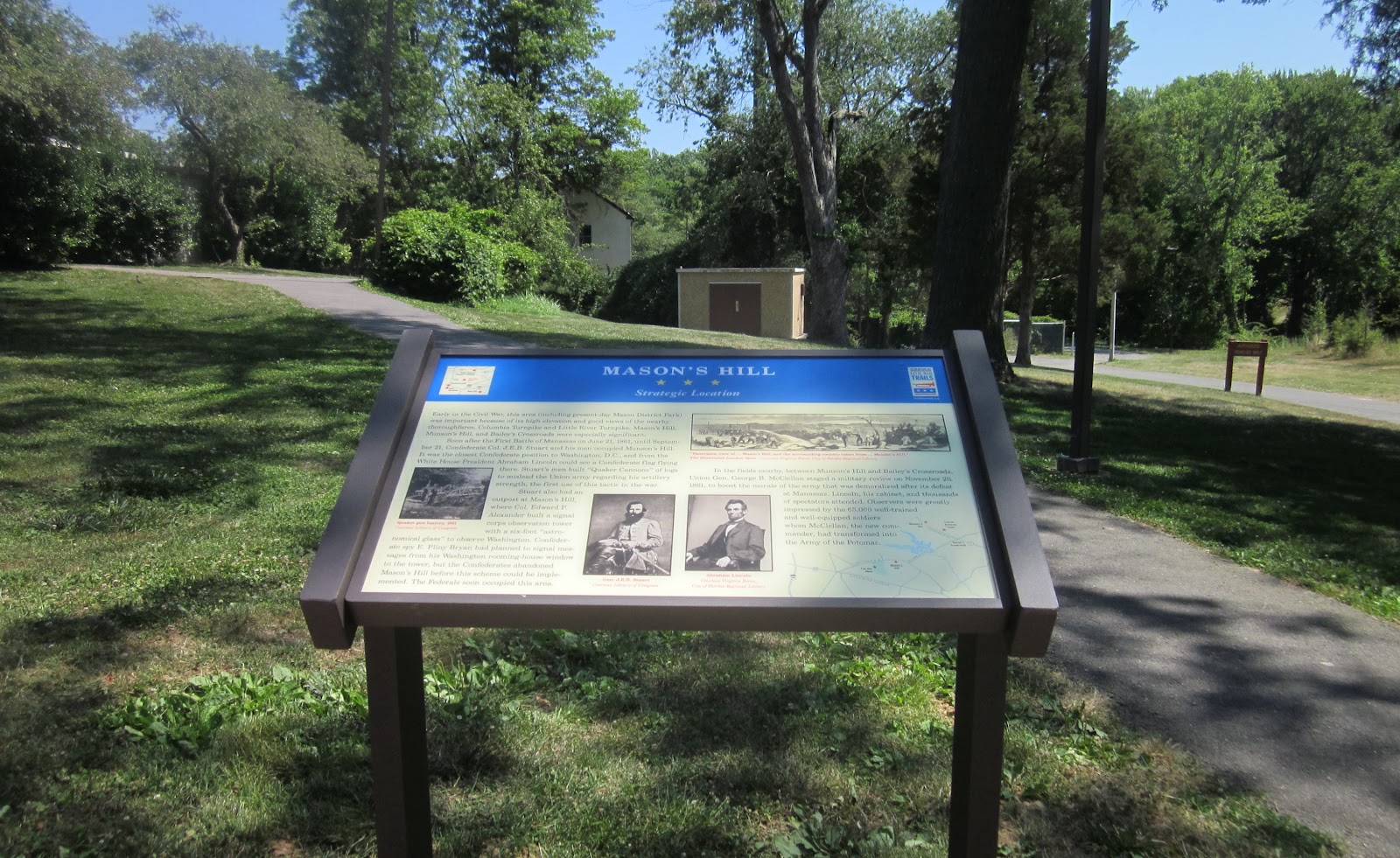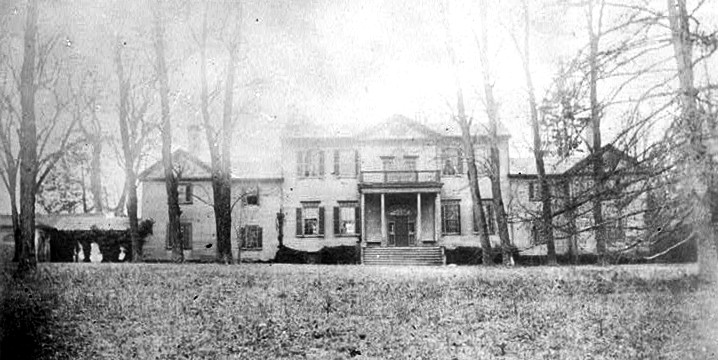New signs explain Civil War events that happened near Annandale
 |
| A new sign in Mason District Park explains the significance of the area during the Civil War. |
Two interpretive signs were installed in the Annandale
area June 20 to commemorate Civil War actions. A sign next to the parking lot
in Mason District Park provides information about Mason’s Hill, a strategic
location during the war, and one next to Ravensworth Shopping Center offers
insights about the Ravensworth mansion.
area June 20 to commemorate Civil War actions. A sign next to the parking lot
in Mason District Park provides information about Mason’s Hill, a strategic
location during the war, and one next to Ravensworth Shopping Center offers
insights about the Ravensworth mansion.
The signs, part of a larger project to educate the public
about the historical significance of this area during Fairfax County’s
observance of the sesquicentennial of the Civil War, are a joint project of the
Fairfax County History Commission and the Fairfax County Civil War 150th Anniversary Planning Committee.
about the historical significance of this area during Fairfax County’s
observance of the sesquicentennial of the Civil War, are a joint project of the
Fairfax County History Commission and the Fairfax County Civil War 150th Anniversary Planning Committee.
Mason’s Hill was important because of its strategic
elevation, offering good views of Columbia Pike and Little River Turnpike, the
sign says. JEB Stuart had an outpost at Mason’s Hill, and Col. Edward P.
Alexander built a signal corps observation tower there with a six-foot
“astronomical glass” to observe Washington, D.C.
elevation, offering good views of Columbia Pike and Little River Turnpike, the
sign says. JEB Stuart had an outpost at Mason’s Hill, and Col. Edward P.
Alexander built a signal corps observation tower there with a six-foot
“astronomical glass” to observe Washington, D.C.
A Confederate spy, E. Pliny Bryan, had planned to signal
messages from his Washington rooming house window to the tower but the
Confederates abandoned Mason’s Hill before this scheme could be implemented. It
wasn’t long before the area was occupied by the Federals.
Nearby is another strategic location, Munson’s Hill in
Bailey’s Crossroads, which was the closest Confederate position to Washington,
D.C. It was occupied by JEB Stuart and his men for about three months after the
First Battle of Manassas in 1861. Munson’s Hill was the first place where
Stuart’s men used “Quaker cannons,” built out of logs, to mislead the Union
Army about their artillery strength.
Bailey’s Crossroads, which was the closest Confederate position to Washington,
D.C. It was occupied by JEB Stuart and his men for about three months after the
First Battle of Manassas in 1861. Munson’s Hill was the first place where
Stuart’s men used “Quaker cannons,” built out of logs, to mislead the Union
Army about their artillery strength.
Also in Bailey’s Crossroads, President Lincoln held a Grand Review of the Troops. The sesquicentennial of that event was commemorated last
November.
November.
The new sign at the Ravensworth shopping center describes
how the Ravensworth mansion, which burned down in 1928, had been a safe haven
at the beginning of the Civil War for Mrs. Robert E. Lee (Mary Randolph Custis
Lee).
how the Ravensworth mansion, which burned down in 1928, had been a safe haven
at the beginning of the Civil War for Mrs. Robert E. Lee (Mary Randolph Custis
Lee).
 |
| Ravensworth Mansion |
There will be dedication ceremonies for those two signs in
late summer or early fall, says Patrick Lennon of Visit Fairfax, who serves as co-chair
of the Fairfax County Civil War 150th Planning Committee.
late summer or early fall, says Patrick Lennon of Visit Fairfax, who serves as co-chair
of the Fairfax County Civil War 150th Planning Committee.
Another six interpretive signs have been installed
throughout the county to mark the sesquicentennial. Two more will be put up
later this summer and another five are expected
to be up by July 2013. The details and locations are still being worked
out. They are likely to be located in places that don’t already have historical
markers, so there won’t be one for the “Action at Annandale.”
throughout the county to mark the sesquicentennial. Two more will be put up
later this summer and another five are expected
to be up by July 2013. The details and locations are still being worked
out. They are likely to be located in places that don’t already have historical
markers, so there won’t be one for the “Action at Annandale.”
The signs will be listed on the maps and guidebooks produced
by Civil War Trails, a private organization that promotes history-related
tourism.
by Civil War Trails, a private organization that promotes history-related
tourism.
The sesquicentennial in Virginia is being commemorated from
2011 through 2015, says Lennon. Most Civil War events that happened in Fairfax
County took place during the first two and a-half years of the war, he says.
After that, the action moved toward Richmond.
2011 through 2015, says Lennon. Most Civil War events that happened in Fairfax
County took place during the first two and a-half years of the war, he says.
After that, the action moved toward Richmond.
On Sept. 1, the committee will commemorate the 150th
anniversary of the Battle of Ox Hill. There will be cannons, horses, guest
speakers, demonstrations, and other family-friendly activities at Ox Hill Battlefield Park on Monument Drive and West Ox Road in Fairfax.
anniversary of the Battle of Ox Hill. There will be cannons, horses, guest
speakers, demonstrations, and other family-friendly activities at Ox Hill Battlefield Park on Monument Drive and West Ox Road in Fairfax.
It’s hard to say whether there’s been an increase in Civil
War-related tourism in Fairfax County during the sesquicentennial so far. “We’ve
definitely seen an uptick in website visits. That is a good indication of
people’s increased willingness to travel,” Lennon says.
War-related tourism in Fairfax County during the sesquicentennial so far. “We’ve
definitely seen an uptick in website visits. That is a good indication of
people’s increased willingness to travel,” Lennon says.
He says the publicity surrounding the sesquicentennial is
raising awareness of what this area used to be like before it was developed.
raising awareness of what this area used to be like before it was developed.
